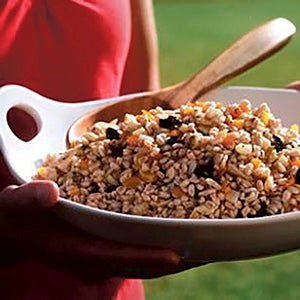Ancient grains have returned
Published 7:01 am Sunday, November 1, 2015
By Courtney Kremer
Hy-Vee Dietitian
Do any of these names sound familiar? Kamut, farro, amaranth, teff, quinoa?
They are all ancient grains, and they’re making a big comeback. They bring variety, culture and nutrition to the table. You can find a variety of ancient grains at your Austin Hy-Vee. Let’s take a closer look at some popular ancient grains:
•Kamut: Kamut is a trademarked variety of ancient Khorasan wheat. It makes a great addition to soups, pilafs and salads. Kamut has more protein and vitamin E than traditional wheat. Fun fact: Some say Kamut was reintroduced after it was brought back from an Egyptian tomb, while others say it had a place on Noah’s ark.
•Farro: Farro (also called emmer) is another ancient variety of wheat. Although it was replaced with the more convenient modern-day wheat in most of the world, it remained an important piece of Italian cooking. Check labels to make sure you’re getting whole-grain farro; the word “pearled” means some of the whole-grain benefits have been removed. Fun fact: Farrotto is the term used for risotto made with farro instead of rice.
•Teff: – Teff may be an ancient grain to folks in the U.S., but it is a current staple in the diets of most Ethiopians. Teff is a nutrition powerhouse. Because the grain is extremely small, it is difficult to mill. This means all teff is whole-grain. Teff is also gluten-free and contains more iron and calcium than other grains. Try teff in porridge or pilafs, or make a traditional Ethiopian meal of teff stew and flatbread. Fun fact: Teff is the smallest grain in the world and its name comes from the word for “lost” in Amharic.
•Amaranth: This tiny grain is actually not a grain at all. It is a “pseudo-grain,” meaning it resembles grains in nutrition and use, but does not belong to the grain family botanically. This gluten-free seed is a complete protein. (No need for meat with amaranth at your meal.) Amaranth is perfect for hot cereals, polenta and quick breads. Fun fact: Amaranth can be popped like corn and is often sold this way in South America.
•Quinoa: Quinoa (pronounced keen-wah) is another “pseudo-grain” native to South America. It is a great substitute for rice or pasta, works well in salads and makes a great hot cereal. It’s also quick-cooking, taking only 10 to 15 minutes to prepare. Like amaranth, quinoa is naturally gluten-free and a complete protein. Quinoa should be rinsed before cooking to remove a bitter residue that occurs naturally on the plant. Pre-rinsed quinoa is available for purchase if you prefer to omit this step in preparation. Fun fact: Quinoa triples in size when cooked (compared to rice, which only doubles in size).
Adding ancient grains to your cooking routine may seem overwhelming, so use product packaging as your guide for a smooth transition. Most product packages list cooking instructions (similar to rice in most cases) and a tried-and-true recipe. Try this recipe in your next meal to try some of these ancient grains today.
Serves 6 (about 1 cup each)
All you need

Roasted Fennel and Farro Salad
•1 cup farro
•2 bulbs fennel, trimmed, cored and coarsely chopped
•2 medium yellow and/or orange bell peppers, chopped
•2 tbsp extra-virgin olive oil
•1/2 tsp salt
•1/2 tsp freshly ground pepper
•1/4 cup oil-cured olives or kalamata olives, chopped
•2 tbsp white balsamic vinegar or white-wine vinegar
•2 tsp chopped fresh thyme
All you do
1. Preheat oven to 400 degrees.
Place farro in a large saucepan; add enough water to cover by 2 inches. Bring to a boil. Cover, reduce heat to a simmer, and cook until tender, 15 to 20 minutes.
2. Meanwhile, toss fennel and bell peppers with oil, salt and pepper in a large roasting pan. Roast, stirring occasionally, until lightly browned and tender, 35 to 40 minutes.
3. Drain the farro; transfer to a large bowl. Add the roasted vegetables, olives, vinegar and thyme; stir to combine. Serve warm, room temperature or cold.
To make ahead: Cover and refrigerate for up to 2 days.
This information is not intended as medical advice. Please consult a medical professional for individual advice.

